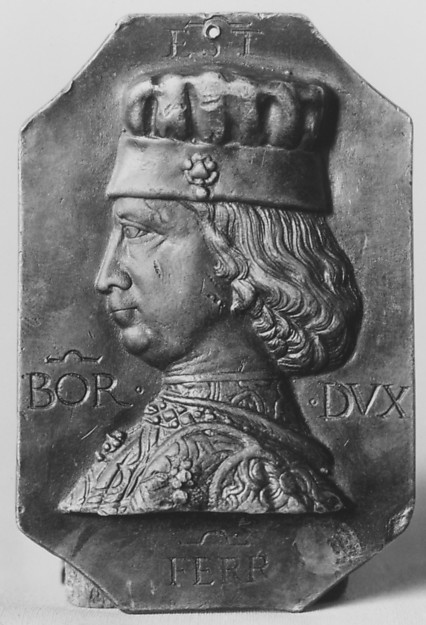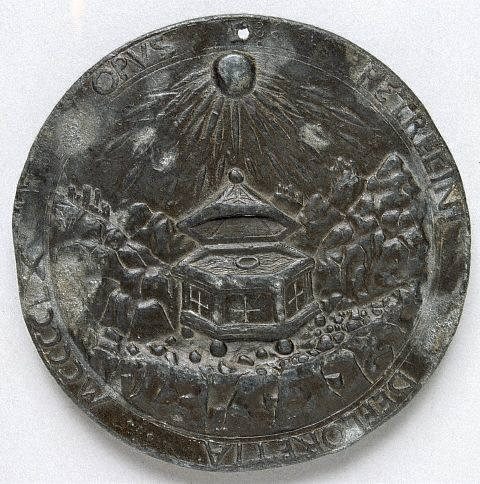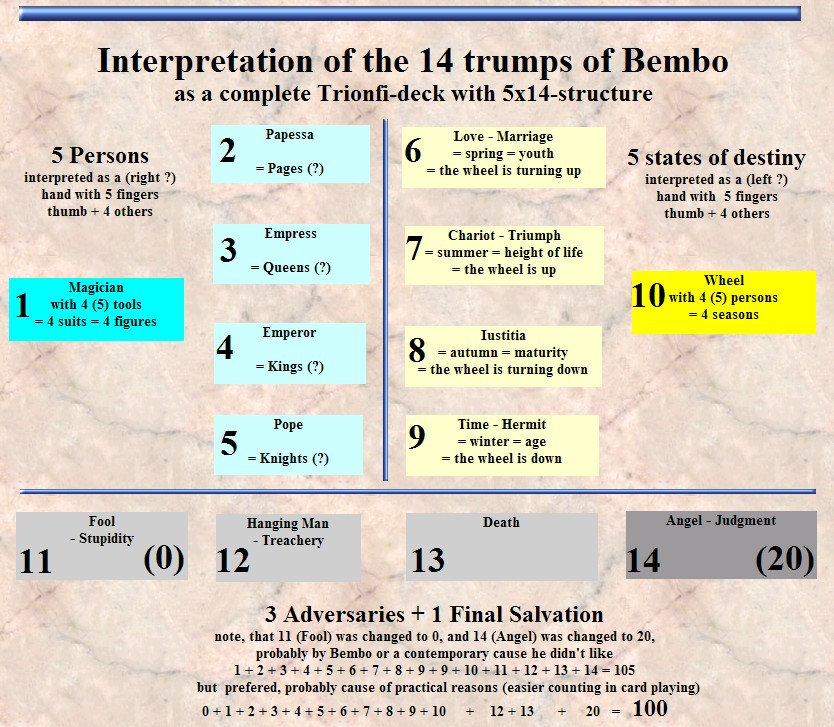http://trionfi.com/0/e/17/
A Petrecino da Firenze is known as the artist of this work, which presents duke Borso:

http://metmuseum.org/Collections/search ... cino&pos=1
He made medals. The date 1471 is possibly not likely (?).
http://www.villaggioglobaleinternationa ... 49_603.pdf
... has the dating 1460, which seems much more plausible, if we assume, that Petrecino da Firenze is identical to Petrecino, the painting page of 1457.
http://www.atlantedellarteitaliana.it/i ... 240&page=315. Petrecino da Firenze
Borso d’Este, 1460
Bronzo (fusione), diametro mm 91
Ferrara, Musei Civici di Arte Antica,
inv. N51139
Hill 96
gives Petrocini da Firenze as active between 1447-1460. The picture shows both sides of a medal.

A greater image of the backside:

Another picture:

http://commons.wikimedia.org/wiki/File: ... 27este.JPG
Further:
http://www.invaluable.com/auction-lot/p ... dwc2rrme2d
PETRECINO DA FIRENZE (active c.1460 in Ferrara), Borso d'Este (1413- 1471), gilt-bronze medal, 1460, BORSIVS. DVX. MVTINE. Z. REGII. MARCHIO. ESTENSIS RODIGII. COMES (Borso, Duke of Modena and Reggio, Marquis of Este, Count of Rovigo), bust left, with long hair, wearing cap with fluted crown and jewel at side and richly brocaded robe with jewels on shoulder and breast, rev., signed and dated OPVS PETRECINI DEFLORETIA MCCCCLX (The work of Petrecino of Florence 1460), a hexagonal font with open lid revealing a ring within, set in a rocky landscape; the sides of the font incised with crosses and the sun, with human face, shining from above; three towns on the mountains in the distance, 96mm, pierced, some wear to the gilding but an extremely fine contemporary cast with elements of the design finely chased in E40000-60000 Literature: Hill 96; Armand I, 33, 1; Kress 36 (lead); B”rner 40; Bargello 27; Johnson/Martini -390 (lead and bronze); Boccolari 58, 37. Provenance: Leu Numismatik, Auktion 74, Zurich, 19- 21 October 1998, lot 720. Little is known of the medallist Petrecino of Florence who made only three signed medals, all in the year 1460. His style is very close to the equally obscure Jacopo Lixignolo who also produced a signed medal of Borso in that year. Hill mentioned a painter of playing cards called Petrecino da Firenze, who, after 1460, entered a monastery. Borso d'Este became Marquis of Ferrara on the death of his brother, Leonello d'Este, in 1450. The Holy Roman Emperor Frederick III gave him the title of Duke of Modena and Reggio in 1452 and Pope Paul II conferred the Dukedom of Ferrara on him and his successors on Easter day, 1471; he died later that year and was succeeded by his brother Ercole d'Este. Besides playing a full role in the turbulent and complex politics of his day, Borso was a great patron of the arts. Bindings and the art of the illuminated manuscript flourished under him - the 'Bible of Borso d'Este' attests to this. Painting, sculpture and architecture, as well as tapestry production, intarsia and medal-making, were commissioned and encouraged. In 1450 the Commune of Modena commissioned Donatello to erect a gilt-bronze statue of Borso in his honour, although the work was never executed. The font on the reverse of the medal is an Este heraldic device. Its placement within a rocky barren landscape may allude to Borso's important irrigation projects which he set up in the country. The very fine chasing on the present medal may well be by the hand of a contemporary goldsmith.
Well, that's interesting. Somebody believes, that also for 1458 a Trionfi card document exists, in which Petrecino participated. That's new to me.
From:
From Borso to Cesare d'Este:
the school of Ferrara 1450-1628 : an exhibition in aid of the Courtauld Institute of Art Trust Appeal, June 1st-August 14th 1984
Courtauld Institute of Art, Matthiesen Fine Art Ltd
http://books.google.de/books?ei=a7RkULD ... rch_anchor
But I find it already in Ortalli 1996, Prince and the Playing Cards. He refers to Adolfo Venturi ...

Page 731in Adolfo Venturi 1885
I don't find it online.
And:
Further I find
http://www.ebooksread.com/authors-eng/l ... -ala.shtml
A similar story I saw told about Petricini 1447 in Ferrara. I got the suspicion, that there might be a dating error, somebody exchanging 1447 with 1477.RAZZANTI, PIETRO DI NERI (7ta/.) . A Florentine Gem-engraver,
born in 1425. He returned to Florence in 1477 after an absence of
several years, and obtained an exemption of state dues on the condi-
tion of his opening a school for the teaching of his art. He was still
living in 1480. Milanesi suggested he may have been the same
person who signed PETRECINI (q . v.} the medals of Borso d'Este
and Gian Francesco Pico della Mirandola, 1460.


